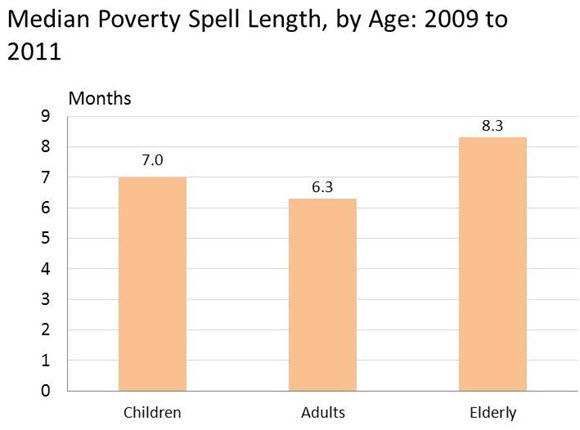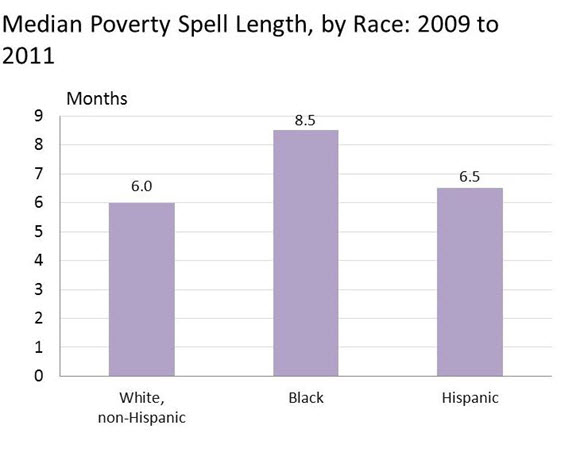Using the Survey of Income and Program Participation to Study Poverty Dynamics
Using the Survey of Income and Program Participation to Study Poverty Dynamics
Some people may see poverty as a continuous state. In fact, it can be temporary. Many people are used to understanding the issue of poverty through annual statistics that provide a snapshot of how many individuals have annual income lower than their poverty threshold. However, estimates of how many people experience short spells of poverty, how many people enter and exit poverty and how many stay in poverty for many years can provide important additional insights.
Longitudinal surveys such as the Survey of Income and Program Participation (SIPP) follow respondents over an extended period and collect data at regular intervals. Using data published from the SIPP in the report Dynamics of Economic Well-Being: Poverty, 2009 to 2011, we find that poverty is not a permanent condition. A small fraction of individuals experience extended, or chronic poverty, while a larger percentage of people experience short poverty spells that are not captured in an annual measure.
Because the SIPP allows us to calculate poverty over longer time periods, and track how people move into and exit poverty, we can see how how poverty experiences vary by demographic characteristics in ways that we are unable to capture when looking at annual measures.
For example, annual measures of poverty show that individuals 65 and older have lower poverty rates than children and nonelderly adults. However, when we use the longitudinal nature of the SIPP to look at how individuals enter and exit poverty, we find that although the elderly were less likely than other age groups to enter poverty over the course of 2009 to 2011, it was difficult for them to exit once they entered a poverty spell.
Over the course of 2009 to 2011, elderly individuals were less likely to exit poverty than adults 18 to 64, and their exit rates were not statistically different from the exit rate for children. The median length of poverty spells was also longer for individuals 65 and older, 8.3 months, compared to children (7.0 months) and adults 18 to 64 (6.3 months).
Note: Excludes spells underway in January 2009. Due to changes in the estimation ofsurvival rates, estimates of median spell length presented in this report are notcomparable with estimates of median spell length reported in previous P70 Dynamicsof Economic Well-Being series.Source: U.S. Census Bureau, Survey of Income and Program Participation, 2008 Panel.For information on confidentiality protection and sampling and nonsampling error, see www.census.gov/programs-surveys/sipp/tech-documentation/source-accuracy-statements.html.
Similarly, when we look at annual poverty rates by race and ethnicity, we find that the rates for Hispanics and blacks were not statistically different. However, this annual measure masks differences in how these groups experience poverty. Over the period from 2009 to 2011, Hispanics were more likely than blacks to enter poverty (10.7 and 8.9 percent respectively) but also more likely than blacks to exit poverty (35.8 and 22.7 percent respectively). As a consequence, the median poverty spell duration for Hispanics was 6.5 months compared to 8.5 months for blacks.
Note: Excludes spells underway in January 2009. Due to changes in the estimation of survival rates, estimates of median spell length presented in this report are not comparable with estimates of median spell length reported in previous P70 Dynamicsof Economic Well-Being series.
Note: Federal surveys, including the SIPP 2008 Panel, give respondents the option of reporting more than one race. These data can be shown in two ways: (1) as mutually exclusive from other race groups, which may be denoted by “alone” or (2) not mutually exclusive with other race groups, denoted by “alone or in combination with other race groups.” This figure shows race using the first method. Because Hispanics may be of any race, data for Hispanics are not mutually exclusive with race.
Source: U.S. Census Bureau, Survey of Income and Program Participation, 2008 Panel. For information on confidentiality protection and sampling and nonsampling error, see www.census.gov/programs-surveys/sipp/tech-documentation/source-accuracy-statements.html.
While the elderly are sometimes overlooked as a vulnerable population due to their declining annual poverty rates, we find that once the elderly enter poverty, they are at a higher risk of becoming stuck in poverty. Similarly, although it may seem from annual poverty rates that Hispanics and Blacks are experiencing similar economic conditions, we find that Hispanics are more frequently churning into and out of poverty, while Blacks are less likely to exit a poverty spell once they’ve entered one.
For additional poverty data from the 2008 SIPP Panel, please see the following:







